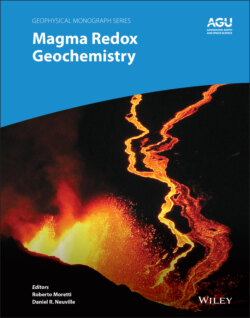Читать книгу Magma Redox Geochemistry - Группа авторов - Страница 29
2.3.1. The Redox State of the Upper Mantle and the Mobilization of Deep C
ОглавлениеCarbon can occur in the Earth’s interior in different forms as elemental species (graphite and diamond), linked with iron as metal carbides (Fe3C, Fe7C3, etc.), in association with hydrogen (e.g., methane CH4 and a variety of aqueous organic and inorganic species) or in oxidized forms such as CO2 carbonates (either liquid or solid). Its fluxing properties are strongly related to the availability of oxygen (redox state) within the surrounding mineral assemblages: elemental carbon passively follows the convection rates of the solid mantle while oxidized carbon present in fluids or melts has its own dynamics, moving through grain boundaries at rates ruled by the fluid mechanics and chemical interactions with minerals (Hammouda & Laporte, 2002; Stagno et al., 2019). The redox state of the convecting oceanic mantle and the continental lithosphere has been recently determined employing oxy‐thermobarometry on natural rocks (mantle xenoliths) from depths of 30–200 km, which is based on the knowledge of ferric/ferrous ratios in redox‐sensitive silicates (Fig. 2.2; Frost & McCammon, 2008; Stagno et al., 2013; Stagno et al., 2015; Stagno, 2019). These studies point out that the upper mantle xenoliths, as sampled at the time of emplacement of the magmatic host rock (predominantly in the Phanerozoic), mostly fall in the diamond stability field (Fig. 2.2), and that fO2 of the lithospheric mantle decreases with the depth to conditions where Fe(Ni) alloy is stable. A large fO2 interval at a given depth is evident, reflecting small variations in the chemistry (or mineral mode) of the plotted rocks and/or the local effect of metasomatism. The experimental calibration of oxybarometers that relies on the Fe3+ of natural garnets can be used to estimate the fO2 of ultrahigh‐pressure metamorphic eclogites and cratonic mantle eclogite xenoliths (Stagno et al., 2015). These results are shown in Fig. 2.2 and demonstrate that peridotite and eclogite rocks record similar mantle redox states. A portion of the mantle likely coexisted with graphite/diamond along with C‐O‐H fluids (Luth & Stachel, 2014) and/or CO2‐bearing silicate melts such as kimberlite, whereas a small fraction coexisted with pure carbonatite (Stagno and Frost, 2010). On the other hand, geochemical evidence employing redox proxies involving multivalent elements, such as V, Ce, and Eu, has been used to claim the constancy of the mantle redox state over the last 3.8 billion years, to values where carbonate melts are expected to be stable. As a consequence, it has been hypothesized that a mantle oxidation event occurred during the crystallization of the proto‐Earth from a magma ocean (Scaillet & Gaillard, 2011), which would imply that most of the deep carbon was mobilized to be released to the atmosphere. Basalts sampling the ambient mantle beneath spreading ridges () are subducted after 200–250 Ma. Older equivalents may be sampled from rare obducted ophiolites, Archean examples of which are, however, extremely rare and have a controversial tectonic setting, as also applies to mafic rocks occurring in greenstone belts (Bickle et al., 1994). One way to derive the redox state of Archean ambient mantle is to determine the V/Sc ratios and Fe3+/∑Fe of ancient basalts from the composition of well‐characterized Archean eclogitic rocks with spreading ridge‐derived mafic protoliths (Aulbach and Viljoen, 2015; Aulbach and Stagno, 2016; Aulbach et al., 2017; 2019). Although these studies find sympathetic behavior of both redox proxies and no evidence for a dominant control of metamorphism and partial melt extraction on V‐Sc‐Fe3+/∑Fe systematics, more work is needed to investigate the redox‐dependent partitioning of V and Fe3+ simulating the metamorphism of basaltic rocks coexisting with C‐O‐H fluids at high pressure and temperature. A complementary view of the deep convecting mantle sampled by thermo(chemical) plumes is provided by komatiites, which are hot, large‐volume melts emplaced predominantly in the Archean and Paleoproterozoic, enabling investigation of the partitioning of V between olivine and melts (Nicklas et al., 2018; 2019) and Fe3+ /∑Fe of melt inclusions contained in komatiite olivine (Berry et al., 2018).
Figure 2.2 LogfO2 (normalized to the FMQ buffer) calculated for mantle peridotite and eclogite xenoliths using oxy‐thermobarometers by Stagno et al. (2013; 2015; 2019). The blue and red lines are the oxygen fugacity calculated along a cratonic geotherm (~44 mW·m‐2) where diamonds (graphite) coexist with carbonatitic and kimberlitic melts, respectively. The purple line is the FeNi precipitation curve (Frost and McCammon, 2008), while the blue dashed line crosses the fO2 at which water is the main component of stable C–O–H fluids. At fO2 ≤ FMQ-3 log units fluids become increasingly CH4‐rich
(modified from Luth and Stachel, 2014).
